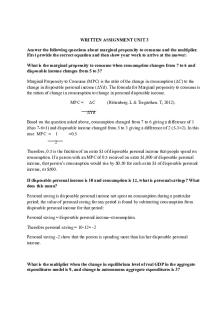Written assignment unit 7(Animal Structure and Function) PDF

| Title | Written assignment unit 7(Animal Structure and Function) |
|---|---|
| Author | Nour Maher |
| Course | Biology 2 for Health Studies Majors |
| Institution | University of the People |
| Pages | 4 |
| File Size | 108.1 KB |
| File Type | |
| Total Downloads | 84 |
| Total Views | 125 |
Summary
Written assignment unit 7(Animal Structure and Function)...
Description
Written assignment unit 7: Animal Structure and Function University of the people Biology 2 for Health Studies Majors Rita Mourya (Instructor) Dec 30, 2021
The effect of the size of the animal Recent studies have confirmed that the body size of many animals is expected to decrease in the near future in response to a warming climate and increasingly changing precipitation levels. Animals on earth are exposed to different pressures, these stresses and influences are related to factors including the size of the animal. The size of the body is an indicator of the age and fertility of the animal, and it also indicates its ability to withstand a lack of cancellation or drought, and any environmental change will affect the size of the animals, which is reflected in the ecosystem in terms of the success of the species (Lister et al., n.d.). In order to illustrate the effect of size on reproduction in animals, I will choose insects, which are the most common among animals on Earth. Insects belong to the family of arthropods and are simple, small animals. Insects reproduce both sexually and asexually, and the reproductive organs have been adapted to do so. They reproduce sexually through the fertilization of the egg by the male. The female stores the sperm in her stomach in specialized sacs called spermathecae. The process of fertilization of the egg is carried out inside the female and then leaves it on a host and later develops to produce a male or female embryo (Beers & warner, 1993). As insects reproduce asexually by the process of parthenogenesis, both males and females produce unfertilized eggs that also develop without fertilization. Insects have the Malpighian tube-organ system, which is the primary system for transporting excretions and toxic compounds. The animal's body size reflects a reduction in its reproductive characteristics (Werner & Griebeler, 2011). The big animal I would choose is the polar bear, which inhabits cold regions and adapts to life in the snow, and is able to fast for several months in the absence of food represented by seals. Reproduction in polar bears is sexual, in which males' mate at the age of eight to ten years, while females are able to mate at the age of five or four even. The breeding process takes place during the hunting process, often during the months of April and May, when the stronger male attracts the
female and mating takes place that may last a whole week for fertilization to occur (Sea World, n.d.).
Animal shape and body size are influenced by environmental factors as well as the presence of an exoskeleton or endoskeleton.
Environmental factors affect the size and shape of the animal. Many animals adapt to the fact that they have an outer shell that protects them from the outer environment. The shape of the organism corresponds to the environment in which it lives. Sea animals have a streamlined body to facilitate their compatibility with the environment in which they live, for example. The animal's metabolism, feeding rate, and respiration also correspond to its size.
The size of the animal does not affect reproduction, it will happen in large and small animals, but the difference is the length of time for reproduction and the number of individuals in a species. As small insects reproduce in greater numbers than large animals, and in return, they are more likely to die quickly, even if through a strong air current.
Word count:457
Reference Beers, E.H., & Warner, G. (1993). Insect Growth and Development. Tree Fruit. http://treefruit.wsu.edu/crop-protection/opm/insect-growth-and-development/
Sea world. (n.d.). Reproduction. https://seaworld.org/animals/all-about/polar-bear/reproduction/
Werner, J., & Griebeler, E.M. (2011, December 14). Reproductive Biology and Its Impact on Body Size: Comparative Analysis of Mammalian, Avian and Dinosaurian Reproduction. Plos one. https://journals.plos.org/plosone/article?id=10.1371/journal.pone.0028442
Lister, A., Twitchett, R., Self, A., White, T., & Collinge, S. (n.d.). Size matters: Responding to environmental change. Natural History Museum. Retrieved December 28, 2021, from https://www.nhm.ac.uk/our-science/our-work/origins-evolution-and-futures/size-matters.html...
Similar Free PDFs

Antibody Structure AND Function
- 9 Pages

Written Assignment Unit 2
- 3 Pages

Written Assignment Unit 7
- 3 Pages

Written Assignment UNIT 5
- 6 Pages

Written Assignment Unit 2
- 5 Pages

Written Assignment Unit 2
- 1 Pages

Written Assignment Unit 6
- 8 Pages

Written Assignment Unit 3
- 4 Pages

Written Assignment unit 3
- 2 Pages

Written Assignment Unit 3
- 2 Pages

Written assignment unit 4
- 5 Pages

Written assignment unit 4
- 4 Pages
Popular Institutions
- Tinajero National High School - Annex
- Politeknik Caltex Riau
- Yokohama City University
- SGT University
- University of Al-Qadisiyah
- Divine Word College of Vigan
- Techniek College Rotterdam
- Universidade de Santiago
- Universiti Teknologi MARA Cawangan Johor Kampus Pasir Gudang
- Poltekkes Kemenkes Yogyakarta
- Baguio City National High School
- Colegio san marcos
- preparatoria uno
- Centro de Bachillerato Tecnológico Industrial y de Servicios No. 107
- Dalian Maritime University
- Quang Trung Secondary School
- Colegio Tecnológico en Informática
- Corporación Regional de Educación Superior
- Grupo CEDVA
- Dar Al Uloom University
- Centro de Estudios Preuniversitarios de la Universidad Nacional de Ingeniería
- 上智大学
- Aakash International School, Nuna Majara
- San Felipe Neri Catholic School
- Kang Chiao International School - New Taipei City
- Misamis Occidental National High School
- Institución Educativa Escuela Normal Juan Ladrilleros
- Kolehiyo ng Pantukan
- Batanes State College
- Instituto Continental
- Sekolah Menengah Kejuruan Kesehatan Kaltara (Tarakan)
- Colegio de La Inmaculada Concepcion - Cebu



